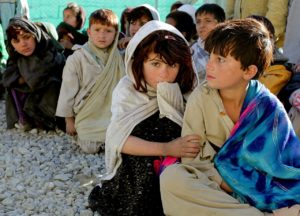As a result of decades of conflict in Afghanistan, the majority of the country’s population is struggling with issues stemming from poverty. Years of instability have left many Afghans insecure about food and basic resources, as well as prospects for the future.
According to The Borgen Project, a nonprofit organization that is dedicated to fighting global poverty through education and advocacy, about 9 million people in Afghanistan—which is a little more than one-third of the population—live in “absolute, extreme poverty.”
An additional 37 percent of people live just above the poverty line. The organization states that Afghans living in poverty face a number of obstacles in trying to improve their lives.
Obstacles to escaping poverty
 For instance, at least half of the people in Afghanistan, including residents of rural and urban areas, do not have access to sources of water. In addition, only about 70 percent of the adult population, which includes those older than 15, can read and write. People who can go to school attend for an average of eight years. Moreover, Afghanistan has the second highest infant mortality rate in the world. Approximately 119 infants die for every one thousand births. With proper medical care, many of these deaths could have been prevented, but Afghanistan averages less than one doctor for every 1,000 people.
For instance, at least half of the people in Afghanistan, including residents of rural and urban areas, do not have access to sources of water. In addition, only about 70 percent of the adult population, which includes those older than 15, can read and write. People who can go to school attend for an average of eight years. Moreover, Afghanistan has the second highest infant mortality rate in the world. Approximately 119 infants die for every one thousand births. With proper medical care, many of these deaths could have been prevented, but Afghanistan averages less than one doctor for every 1,000 people.
UNICEF estimates that in 2011, about 30 percent of children ages 5-14 were used as child laborers. That means at least one-fourth of Afghanistan’s children are not receiving an education. While aid organizations that work in Afghanistan acknowledge the difficulty of helping Afghans to move out of poverty, many continue to work to help people become self-sufficient and obtain access to basic needs.
Following are some of the organizations and projects focused on helping people in need in Afghanistan.
1. The World Food Programme
The World Food Programme is fighting poverty on several fronts. Its school meals program provided more than 255,000 students take-home rations of fortified vegetable oil to incentivize parents to send their children to school. The organization has also given hundreds of thousands of food baskets to people who are vulnerable, and it has helped refugees and others who are displaced within the country. In addition, it has provided returnees with emergency food assistance.
2. An appeal for international assistance
In October, Afghan President Ashraf Ghani asked for long-term international assistance and promised that the government would be “relentlessly focused on the reduction and elimination of poverty.” Ghani spoke before representatives of more than 70 countries, non-governmental organizations, and agencies at a conference hosted by the European Union.
3. Organized sports teams

Some organizations are developing organized sports teams in an effort to bring a sense of value and normalcy to people’s lives. One group is seeking to make mixed martial arts a professional sport in Afghanistan. Kakal Noristani and his partners hope that the sport will help Afghans to relieve social frustration and provide a welcome distraction from poverty-related issues for spectators. A Red Cross International Committee group has formed a wheelchair basketball league that is providing hope to people who have been disabled by war or illness.
4. Action Against Hunger
Since 1995, Action Against Hunger, an NGO, has fought hunger in Afghanistan. The organization provides practical assistance to address issues such as child malnutrition, unsafe water, and poor hygiene.
5. USAID’s partnership with the Afghan government
In light of a report issued in May showing that Afghanistan’s socio-economic progress faces growing risks, Shubham Chaudhuri, Afghanistan country director for the World Bank, emphasized the need to ensure that more Afghans benefit from economic growth and do not fall into poverty. Efforts already in place include USAID’s partnership with the Afghan government, which includes providing business development services, investing millions of dollars in equipment and private enterprise to create jobs, improving trade, and helping Afghans to secure loans.
6. Cultivation of new markets and businesses
Some organizations are helping Afghans to cultivate new businesses and open new markets in Afghanistan. Rehabilitation Association and Agricultural Development for Afghanistan, for example, has helped people cultivate silkworms—a traditional Afghan craft that had become less popular—in their homes. Some have seen a significant increase in their income from this new enterprise. Christian Aid is working with the European Union to plant and cultivate a variety of fruit trees and extend growing seasons with greenhouses.
Officials hope that the conflict in Afghanistan eventually will decrease, which will allow the government and other agencies to build a solid infrastructure and systems to help the country heal and move forward. In a peaceful environment with improving conditions, the people of Afghanistan and partner organizations can begin to take steps toward a more stable and self-sufficient future.

